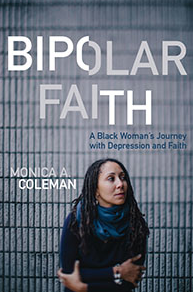In this RD10Q, AME minister and womanist theologian, Monica A. Coleman explores the underexamined intersection of faith, race and mental health.
What inspired you to write Bipolar Faith?
I like to read memoirs because it gives me an insight into how someone wrestled with difficulties and managed or overcame them. About 14 years ago, I was living in a deeply depressive state, and I began to seek out memoirs of mental illness to hear from other people. I wanted to know I wasn’t alone. I wanted to see how they managed their condition, so I could learn from them.
These books were incredibly meaningful to me, but I still never saw anything that reflected my experiences. There weren’t any books by people who live with bipolar II, which is my condition. There was only one book by a black woman, Willow Weep for Me by Ghanaian immigrant Meri Danquah, and so our cultural and historical experiences were very different. And there were no books that really discussed how one wrestled with faith in the midst of it all—although Therese Borchard’s book Beyond Blue came out a couple years later. I wrote Bipolar Faith to show this experience—one with bipolar II; one that has faith, doubts, loses faith and finds it again and again; and one that reflects the particularity of African American experiences.
What’s the most important take-home message for readers?
It’s complicated. I want readers to understand that mental health challenges are complex. History and culture and race and family and genetics and trauma and fear all factor into what cause mental health challenges. Class, education and privilege may make a difference with accessing healthcare, but they don’t protect one from the angst of these conditions.

Bipolar Faith: A Black Woman’s Journey with Depression and Faith
Monica A. Coleman
Fortress Press
July 2016
Our faith is also complex. My story is about being raised in black church traditions and answering a call to ordained ministry. It is also about how I stopped praying to God, how I did ministry without being on speaking terms with God, and how I find faith within and outside the faith of my teenage self. I find faith in ancestors and dance and poetry and community and music and academic theology. Our mental health and spiritual lives are complicated.
Is there anything you had to leave out?
I had to leave out a lot about my journey to becoming a minister, how I struggled with that calling as a young woman in the early 1990s, and how I found my way to live into that calling. It was a big part of my experience that couldn’t stay in the book the way I had originally hoped.
What are some of the biggest misconceptions about your topic?
Few people know much about bipolar II, so people assume that the only kind of bipolar depression is the kind they see portrayed on television—those with high, dangerous manias that may cause people to spend a lot of money, feel unconquerable and engage in seemingly reckless behavior.
Likewise, few people outside of trained pastoral counselors understand how depressions can really cause one to question faith and feel faithless. Even the most conscientious clergy often share messages about what is required for faith, or how to understand stress vis-a-vis blessings, that diminish the very real experience of living with a mental health challenge.
Did you have a specific audience in mind when writing?
In many ways, I wrote this book for myself and the people who love me. I imagined the book would be meaningful for people who live with depression and/or bipolar, especially people who are also of faith. I also imagined the book would be meaningful for people who know, love, minister and care for people who live with depression and/or bipolar conditions. I wanted to offer a first-person narrative for professionals who care about the intersection of health and faith, so they could see some of the issues that arise.
Are you hoping to just inform readers? Entertain them? Piss them off?
I wanted to give a sense of what it feels like to experience depression, suicidal ideation, the trauma of rape, and let readers know that it’s possible to get to another side of the hardest times. I also hope to inspire people by teaching that there really is a way of integration and health—even if you have to go through some tough places to get there.
What alternative title would you give the book?
My original title for the book was “Free.” I imagined the book as a slave narrative or captivity narrative. There is freedom from being owned by one’s condition, from being afraid of it and having your very life threatened by this enemy from within. And there is freedom to understanding a mental health challenge as part of one’s life. I wanted to emphasize that freedom is often hard-won. The final chapter is now named “Free.”
How do you feel about the cover?
Initially, I resisted having my face on the cover of the book. When the publishers presented the idea to me, I gave them a list of all the memoirs without the author’s face on the cover. They gave me a comparable list of memoirs that have the author’s face on the cover. Between the Atlanta-based photographer Anne Simone and cover designer Brad Norr, I felt confident that they could put together something appropriate and poignant. The photo on the cover was caught between posed pictures when I got cold and wrapped my scarf around me as we moved from one location to another. Anne said, “Don’t move!” And there we had it. I like the color scheme, and I think it conveys a sense of security and hope in the future.
Is there a book out there you wish you had written? Which one? Why?
I wish I had written Traveling Mercies by Anne Lamott. I like how she portrays her faith in ordinary ways that bring grace, depth and humor to the spiritual journey. I don’t think I’m as funny as she is, sometimes I wish I had that kind of humor. But it’s a powerful and accessible way of talking about meeting the holy. I teach it in my course entitled “Theology for Social Justice” at Claremont School of Theology.
What’s your next book?
I have been thinking of following up Bipolar Faith with a kind of lifestyle book about how one works out one’s mental health and faith on a daily basis: diet, exercise, ritual, prayer, forgiving yourself, parenting, spiritual practices. That book would answer the question I get asked the most: what are my spiritual practices? Or how do I live faithfully with a mental health challenge? I’ve done a show on Periscope on this topic (most are now on my YouTube page), and these questions continue to be the most persistent inquiries when I’m on tour and talking with audiences.





